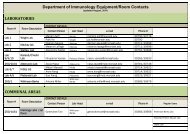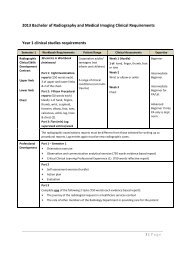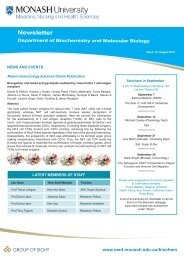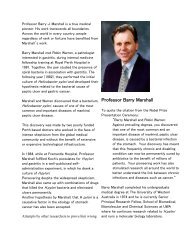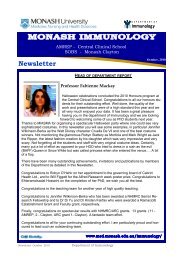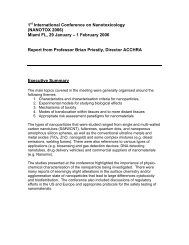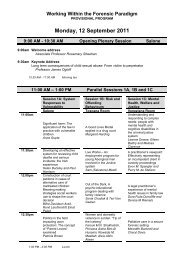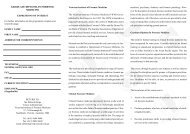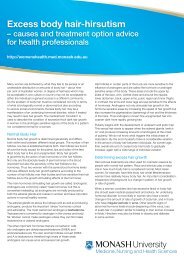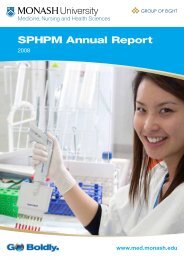Link to Letter in Nature - Monash University
Link to Letter in Nature - Monash University
Link to Letter in Nature - Monash University
You also want an ePaper? Increase the reach of your titles
YUMPU automatically turns print PDFs into web optimized ePapers that Google loves.
mouse anti-human CD3e (5 mgml 21 OKT3; eBioscience) for 15 m<strong>in</strong> on ice,<br />
washed and stimulated by crossl<strong>in</strong>k<strong>in</strong>g with goat anti-mouse immunoglobul<strong>in</strong><br />
G (20 mgml 21 )at37uC for 30 m<strong>in</strong>. Cells were fixed with 0.5% (w/v) paraformaldehyde<br />
for 30 m<strong>in</strong>, washed with PBS conta<strong>in</strong><strong>in</strong>g 3% (v/v) FBS and resuspended <strong>in</strong><br />
PBS conta<strong>in</strong><strong>in</strong>g 5% (v/v) FBS plus 0.1% (w/v) sapon<strong>in</strong> plus primary antibody<br />
(OKT3 or anti-TCRb), and <strong>in</strong>cubated at room temperature for 1 h. Cells were<br />
then washed and <strong>in</strong>cubated with the same buffer plus secondary antibody (Alexa<br />
Fluor 568 goat anti-mouse; Invitrogen-Molecular Probes) for 30 m<strong>in</strong>. Washed<br />
cells were then sta<strong>in</strong>ed for DNA with Hoechst 33258 (Invitrogen-Molecular<br />
Probes) for 10 m<strong>in</strong>, collected on<strong>to</strong> glass slides by centrifugation (500 g, 5 m<strong>in</strong>)<br />
and processed for microscopic analysis us<strong>in</strong>g a Zeiss Axioskop 2 MOT Plus epifluorescence<br />
microscope (Zeiss).<br />
21. CCP4. The CCP4 suite: programs for prote<strong>in</strong> crystallography. Acta Crystallogr. D<br />
50, 760–763 (1994).<br />
22. Adams, P. D. et al. PHENIX: build<strong>in</strong>g new software for au<strong>to</strong>mated crystallographic<br />
structure determ<strong>in</strong>ation. Acta Crystallogr. D 58, 1948–1954 (2002).<br />
LETTER RESEARCH<br />
23. Zwart, P. H. et al. Au<strong>to</strong>mated structure solution with the PHENIX suite. Methods Mol.<br />
Biol. 426, 419–435 (2008).<br />
24. Emsley, P. & Cowtan, K. Coot: model-build<strong>in</strong>g <strong>to</strong>ols for molecular graphics. Acta<br />
Crystallogr. D 60, 2126–2132 (2004).<br />
25. Cole, J. L. et al. Analytical ultracentrifugation: sedimentation velocity and<br />
sedimentation equilibrium. Methods Cell Biol. 84, 143–179 (2008).<br />
26. Schuck, P. Size-distribution analysis of macromolecules by sedimentation velocity<br />
ultracentrifugation and Lamm equation model<strong>in</strong>g. Biophys. J. 78, 1606–1619<br />
(2000).<br />
27. R<strong>in</strong>ner, O. et al. Identification of cross-l<strong>in</strong>ked peptides from large sequence<br />
databases. <strong>Nature</strong> Methods 5, 315–318 (2008).<br />
28. Burger, R., Hansen-Hagge, T. E., Drexler, H. D. & Gramatzki, M. Heterogeneity of<br />
T-acute lymphoblastic leukemia (T-ALL) cell l<strong>in</strong>es: suggestion for classification by<br />
immunophenotype and T-cell recep<strong>to</strong>r studies. Leuk. Res. 23, 19–27 (1999).<br />
29. Hirano, T. et al. In vitro immune response of human peripheral lymphocytes: IV.<br />
Specific <strong>in</strong>duction of human suppressor T cells by an antiserum <strong>to</strong> the T leukemia<br />
cell l<strong>in</strong>e HSB. J. Immunol. 123, 1133–1140 (1979).<br />
30. Holst, J., Vignali, K. M., Bur<strong>to</strong>n,A. R. & Vignali, D. A. A. Rapid analysis of T-cell selection<br />
<strong>in</strong> vivo us<strong>in</strong>g T cell-recep<strong>to</strong>r retrogenic mice. <strong>Nature</strong> Methods 3, 191–197 (2006).





